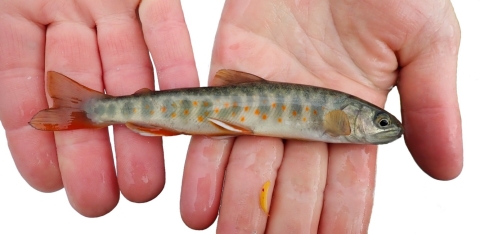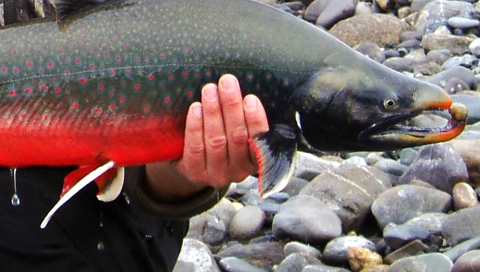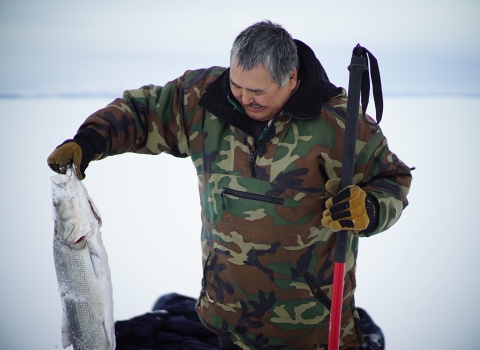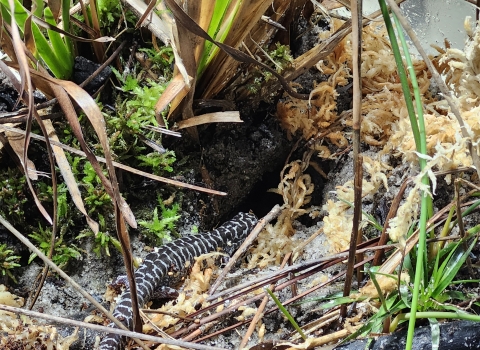Going out to eat isn’t usually rife with danger. Worst case scenarios: bad company, bad service, food poisoning. But not typically death. That’s our reality. Fish have a different reality. Especially in Arctic National Wildlife Refuge, where salmon-sized Dolly Varden play a high stakes game of eating out or staying in.
Seafood Buffet
When I was a kid, we’d splurge for Captain George’s seafood buffet on special occasions. I’d stuff my face with the most calorically-opulent items. The crab legs. The scallops. The fried shrimp. Even then, I knew not to waste space on salad or bread. Fish know it too.
The oceans surrounding Alaska are a bona fide buffet of highly nutritional prey. So enticing is the smorgasbord, that species born in freshwater are tempted into arduous seaward migrations just to partake. We see this behavior (anadromy, if you want to get nerdy) where the ocean’s meal plan is crushing it, but freshwaters offer safer nursery and wintering options.
Anadromy allows fish to straddle both worlds to exploit the best of each. It dominates Alaska’s fish scene—there are ~20 anadromous species here, with Pacific salmon being perhaps the most familiar.
It’s also risky. The ocean is a black box and many fish don’t make it back alive. But those that do reap big benefits.
Extreme Eating
In Arctic, America’s largest and northernmost National Wildlife Refuge, anadromous Dolly Varden have arguably the shortest window to get their eat on (40–51 days, to be exact). The remainder of the year, in freshwater, the vast majority have empty stomachs. Leaving rivers like the Canning, Hulahula, and Kongakut for the Beaufort Sea in early- to mid-June after ice out, their goal is simple: gorge on Arctic Cod and other saltwater prey. In mid-July, they start heading back up river to seek shelter in perennial springs that don’t freeze up. A little over half of the mature population makes it. The other half dies each year, mostly at sea.
Let that sink in.
When Dollies come of age (typically at six to nine years old), some appear to become risk averse, skipping the seafood buffet entirely. This can mean foregoing a good meal for an epic twenty months or more.
Hungry for Love: the timeline
What does one do during twenty months of fasting? That’s longer than it takes to get over the average break-up. Longer than a (theoretical) trip to Mars and back. Not eating the whole time. To answer this question, we radio-tagged 210 anadromous Dolly Varden and followed them around for several years.
Dolly #1–12
We’ll call him Carl Dean. He saw a delectable lure on August 30, 2014 and took a munch. After being sedated briefly by a weird bearded creature, he continued upstream to the relatively balmy 41.9 °Fwaters of Shublik Spring, a rare year-round source of unfrozen water. In 2015, Carl played it safe and skipped the summer buffet. He met a special lady that fall and spawned up Eagle Creek, then found his way back to Shublik to avoid the deep freeze. After a whopping 21+ month hiatus from eating, Randy’s fixed location receiving station recorded Carl swimming towards sea June 19, 2016. Two months later, he was back. He skipped the spawn, and overwintered in the lower river along the western boundary of the Refuge’s 10-02 area. Randy last tracked him June 14, 2017, headed back to sea.
Dolly #2–69
Jolene, a rare two-years-in-a-row spawner, got outfitted with a radio tag July 21, 2015. She preferred the Canning’s Marsh Fork, and the perennial spring that fed into it. Perhaps she and Carl Dean met somewhere under the bluish-green hue of the Canning — they passed Randy’s radio station within two days of each other on their way to sea in June of 2016. She returned before him, on August 9th, spawning for her second and last time in the Marsh Fork, and overwintering there too. That was the last song she wrote.
To fast or feast?
While each of the 210 fish has their own unique story, there are some patterns:
Around 40 percent (two out of five) skip the buffet before spawning. Initially, fasting for 20 months seems like a poor choice leading into such an important life event. It’s not: every single tagged fish that chose freshwater fasting over seafood buffet the summer prior was still alive entering the fall. Yeah, they lost as much as 50% of their energy reserves in so doing, but the population almost doubled its reproductive success. When living past 10 and spawning twice is a rarity, fasting appears to be a good, safe way to bump up the not-so-great odds of successful reproduction. But it’s rough on survival. Compared to their peers, fish that spawned were less likely to survive the winter, make it to sea, and avoid predators once they got there.
Hope Springs Eternal
While we hopefully usually enjoy good food with good company, the Jolenes and Carl Deans will continue making important decisions like whether to fast or feast. As we roll into summer, they’ll be following the spring freshets out to sea, navigating complicated braided river deltas, filling their bellies, and nosing their way back up rivers like the Canning, Aichilik, Egaksrak, Kongakut, and Firth. Some will eat, some will spawn, many will die. So long as the perennial springs keep flowing and the sea keeps giving and taking, this cycle will continue as it has for thousands of years.
Get technical
Brown, Randy J., Courtney, Michael B. and Andrew C. Seitz. October 2018. New Insights into the Biology of Anadromous Dolly Varden in the Canning River, Arctic National Wildlife Refuge, Alaska. Transactions of the American Fisheries Society.
Dandy Dollies of Far-North Alaska: A Conversation with Fish Biologist Randy Brown
We honor, thank, and celebrate the whole community — individuals, Tribes, States, sister agencies, fish enthusiasts, scientists, and others — who have elevated our understanding and love, as people and professionals, of all the fish. In Alaska we are shared stewards of world renowned natural resources and our nation’s last true wild places. Our hope is that each generation has the opportunity to live with, live from, discover and enjoy the wildness of this awe-inspiring land and the people who love and depend on it.









